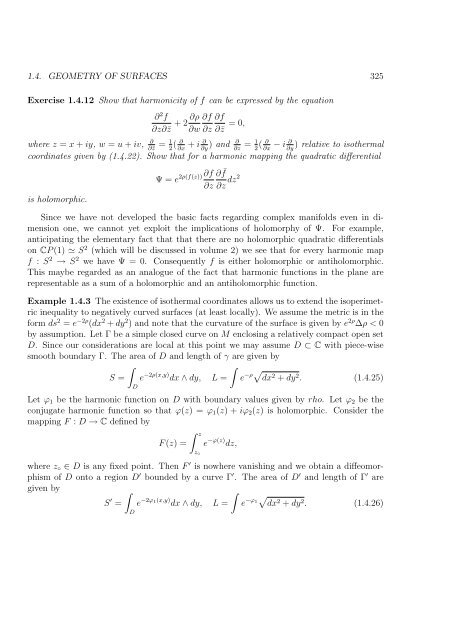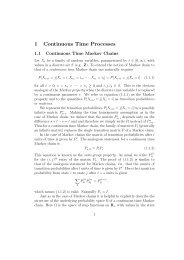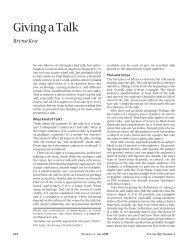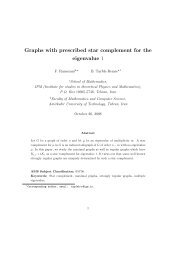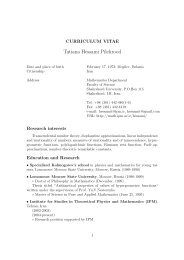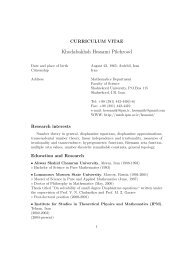Chapter 1 DIFFERENTIAL GEOMETRY OF REAL MANIFOLDS
Chapter 1 DIFFERENTIAL GEOMETRY OF REAL MANIFOLDS
Chapter 1 DIFFERENTIAL GEOMETRY OF REAL MANIFOLDS
Create successful ePaper yourself
Turn your PDF publications into a flip-book with our unique Google optimized e-Paper software.
1.4. <strong>GEOMETRY</strong> <strong>OF</strong> SURFACES 325<br />
Exercise 1.4.12 Show that harmonicity of f can be expressed by the equation<br />
where z = x + iy, w = u + iv, ∂<br />
∂¯z<br />
∂2f ∂ρ ∂f ∂f<br />
+ 2<br />
∂z∂¯z ∂w ∂z ∂¯z<br />
= 1<br />
2<br />
( ∂<br />
∂x<br />
+ i ∂<br />
∂y<br />
= 0,<br />
) and ∂<br />
∂z<br />
= 1<br />
2<br />
( ∂<br />
∂x<br />
∂ − i ) relative to isothermal<br />
∂y<br />
coordinates given by (1.4.22). Show that for a harmonic mapping the quadratic differential<br />
is holomorphic.<br />
2ρ(f(z)) ∂f ∂<br />
Ψ = e<br />
∂z<br />
¯ f<br />
∂z dz2<br />
Since we have not developed the basic facts regarding complex manifolds even in dimension<br />
one, we cannot yet exploit the implications of holomorphy of Ψ. For example,<br />
anticipating the elementary fact that that there are no holomorphic quadratic differentials<br />
on CP (1) S 2 (which will be discussed in volume 2) we see that for every harmonic map<br />
f : S 2 → S 2 we have Ψ = 0. Consequently f is either holomorphic or antiholomorphic.<br />
This maybe regarded as an analogue of the fact that harmonic functions in the plane are<br />
representable as a sum of a holomorphic and an antiholomorphic function.<br />
Example 1.4.3 The existence of isothermal coordinates allows us to extend the isoperimetric<br />
inequality to negatively curved surfaces (at least locally). We assume the metric is in the<br />
form ds 2 = e −2ρ (dx 2 + dy 2 ) and note that the curvature of the surface is given by e 2ρ ∆ρ < 0<br />
by assumption. Let Γ be a simple closed curve on M enclosing a relatively compact open set<br />
D. Since our considerations are local at this point we may assume D ⊂ C with piece-wise<br />
smooth boundary Γ. The area of D and length of γ are given by<br />
<br />
S = e −2ρ(x,y) <br />
dx ∧ dy, L =<br />
D<br />
e −ρ dx 2 + dy 2 . (1.4.25)<br />
Let ϕ1 be the harmonic function on D with boundary values given by rho. Let ϕ2 be the<br />
conjugate harmonic function so that ϕ(z) = ϕ1(z) + iϕ2(z) is holomorphic. Consider the<br />
mapping F : D → C defined by<br />
F (z) =<br />
z<br />
z◦<br />
e −ϕ(z) dz,<br />
where z◦ ∈ D is any fixed point. Then F ′ is nowhere vanishing and we obtain a diffeomorphism<br />
of D onto a region D ′ bounded by a curve Γ ′ . The area of D ′ and length of Γ ′ are<br />
given by<br />
S ′ <br />
=<br />
D<br />
e −2ϕ1(x,y)<br />
<br />
dx ∧ dy, L =<br />
e −ϕ1<br />
<br />
dx2 + dy2 . (1.4.26)


